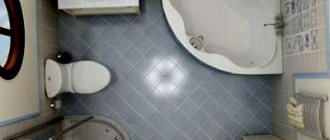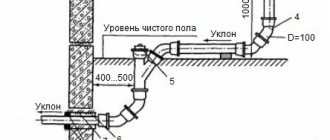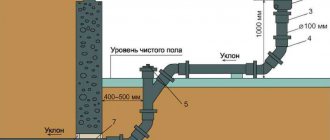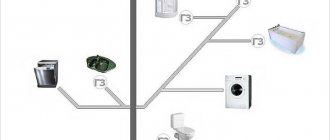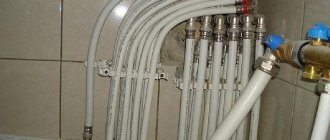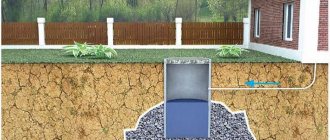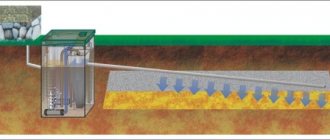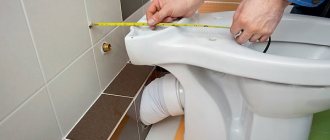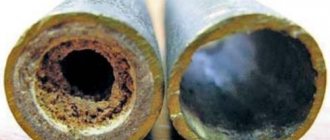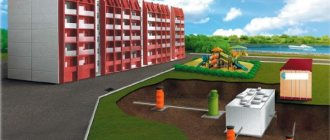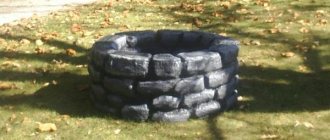Content:
- Components of the sewer system
- Choosing sewer pipes
- Interior of the sewer
- External sewage system of a wooden house
- cesspool
- Septic tank
- Deep biological treatment stations
- Sewage installation for your country house
- Video on sewerage in a wooden house
Sewage in a wooden house is often autonomous, and you have to arrange it yourself. To do this, you need to know all the intricacies of placing communications both inside and outside the house. You also need to think in advance where the waste collection site will be and how it will be disposed of.
Toilet in a country house
Many people think about how to make a toilet in the country; most summer residents still have lonely houses in their gardens. Some are trying to arrange a toilet modeled after a city one. That is, a toilet is installed, and the waste discharge passes through the sewer pipe to the drainage settling point. There should be dug or concrete rings, and a special container installed. And at least once a year you will have to call a vacuum cleaner to clean the cesspool. And in between there have appeared many options for arranging country toilets. More on this below.
Some summer residents go a different route. They simply attach an outdoor toilet to an existing house, but before attaching a warm toilet to a wooden house, they need to see how the structure of the house as a whole behaves.
Components of the sewer system
The sewerage diagram shows the placement of all the constituent elements of the sewerage system. In total, there are three main groups of parts.
Components of the sewer system:
- The internal structure is represented by pipes and plumbing fixtures.
- The external outlet of wastewater is represented by communications that ensure delivery of waste to the processing site.
- Septic tanks and other treatment systems. They can simply accumulate waste or recycle it.
The choice of each element depends on the characteristics of the site itself. Communications must meet certain requirements. Much depends on the volume of operation of the structures.
Choosing sewer pipes
It is important to understand how to make a sewer system in a wooden house yourself, even if the work is performed by professionals. You can choose the material yourself. And orientation in all processes will help control the installation of wastewater disposal systems.
It is best to use plastic pipes for sewerage. The optimal diameter for risers is 110 mm, and for bends - 50 mm. External sewerage can be made of eurocast iron. Popular use of products made from domestic materials.
Plastic pipes for external sewerage are also popular, but their characteristics have distinctive features from those for internal drainage.
Features of different materials:
- Cast iron. Able to withstand significant loads and last a long time. But the material is heavy and fragile. During operation, corrosion and roughness are formed, which negatively affects the permeability of the pipes.
- Polypropylene. Has no disadvantages. Among the advantages are flexibility, lightness and stability.
- Polyvinyl chloride. The material will last a long time. It is quite durable, lightweight and affordable. But there is no resistance to high temperatures.
Eurocast iron has undeniable advantages. This is a sustainable, durable and environmentally friendly material. Pipes are installed using clamps. Be sure to use rubber gaskets, and the joints are tightened together with bolts.
Domestic cast iron is not inferior in quality to European analogues. But there are slight differences in the assembly. To connect them, the socket method is used. The communications are inserted into each other and then sealed with a bundle.
Plastic pipes for external and internal sewerage differ in color. For the street, bright shades are used for communications so that they can be noticed during excavation. The pipes are also more durable so that they can withstand internal and external pressure.
What to consider when installing sewerage in a timber house
Finally, the decision has been made. The first step towards its implementation is the development of a design for a sewer system in a house made of timber. Everything needs to be carefully thought out, taking into account the characteristics of your house and the prospects for its redevelopment and expansion. Make detailed calculations regarding sewerage, based on many factors, design and financial capabilities.
The most important factor influencing the design is the volume of water that will likely be used by the occupants of the home. This indicator is calculated taking into account the number of water intake points and the total number of users of plumbing fixtures. The list of plumbing fixtures includes not only bathtubs, sinks, toilets, showers, but also dishwashers and washing machines, swimming pools, etc. It is important to take into account the type and number of devices that collect water and form drains, and correctly position these devices, taking into account the requirements for the design of sewer systems.
Another factor that needs to be given serious attention is where the wastewater collection area will be located on your property or where the septic tank will be located. It is advisable to highlight this zone at the stage of developing a country house project.
It is imperative to take into account existing sanitary standards and rules and understand that septic tanks (or a cesspool) must be located at a certain distance from residential buildings, roads, etc. so that they do not cause harm to your health and are not damaged. If you place a septic tank in an irrationally chosen place, it will no longer be possible to move it anywhere, since this is due to its connection to sewer pipes and sanitary areas. Therefore, take your time and think carefully about everything in advance.
When choosing a material for sewerage in a house made of timber, builders often give preference to plastic pipes, abandoning cast iron ones. Despite the fact that cast iron pipes are stronger and more durable, they are significantly more expensive and heavier. In addition, over time, metal corrosion occurs inside them, the rate of development of which is related to the quality of the discharged water. As a result, the inside of the drain pipes becomes rough, which increases the risk of clogging.
Practice has shown that the use of pipes made of polypropylene or polyvinyl chloride is much more rational. They are quite durable (especially polypropylene pipes), reliable and easy to use. In addition, these pipes are significantly cheaper, and everyone can install them and, if necessary, repair them themselves.
Please note that the pipes used for external and internal work are of different types. The reason lies in the different operating conditions. Let's say, pipes located outside the building, passing underground, carry heavy loads from the layer of earth pressing on them. In addition, during the winter they are exposed to very low temperatures. Accordingly, their strength should be higher. External pipes are orange in color (as opposed to white and gray indoor pipes). This makes it easier to detect them in the ground if dismantling or repair work is necessary.
Pipes for external use must be installed below the freezing depth of the soil. There are specially calculated indicators for Russia depending on the region. On average, pipes are laid no higher than 70 cm and lower than 2-3 meters from the ground surface.
It would be better if they were additionally insulated. For these purposes, there are heat-insulating materials and, as an option, thermal cables. Types of thermal insulation for sewer pipes: rolled and molded. If your choice is made in favor of using a thermal cable, you have the opportunity to buy pipes with a cable already built into the design.
Interior of the sewer
The main thing is to take care of the close location of all communications horizontally and vertically. This reduces the length of the pipes, which will allow wastewater to be discharged faster. You also need to take care of your convenience.
Internal sewerage communications:
- Bathroom, sink, toilet and other plumbing fixtures;
- Communication outlets;
- Risers;
- Ventilation tube.
The diameter of pipes for internal sewerage is usually 40-50 mm. Only the toilet requires a size of 110 mm. All pipes are connected to a common riser. You can use tees for connections. It is recommended to install inspections at each bend of communications. This will allow you to quickly deal with any blockage.
Pipes indoors can be hidden in walls, niches or special boxes.
It is imperative to provide for the installation of water seals. The installation of the ventilation pipe is also important. It not only removes unpleasant odors, but also increases the service life of the entire system. Combining fan communication with other house hoods is prohibited.
External sewage system of a wooden house
When considering how to install a sewer system in a wooden house, many questions relate to the external arrangement. The main requirement for external sewerage pipes is compliance with the slope. The indicator depends on the diameter of communications. Usually it fluctuates around 2-3 degrees. The effluent will eventually end up in a filtration or storage facility. This can be a septic tank, a cesspool and a biological treatment station.
Construction of tanks for storing and processing wastewater
There are several options for containers into which wastewater will flow and then be processed there. The simplest of them is a cesspool. The method involves forming a depression in the soil into which a container made of reinforced concrete, plastic or brick is installed.
Construction of tanks for storing and processing wastewater
Cesspools are not a good option for arranging the final circuit of an external sewer system to which a wooden dwelling is connected. The reason is the poor quality of sewage treatment and contamination of nearby soils.
The best option is to install a septic tank. To install it, you must meet a number of requirements:
- the distance from the septic tank to the nearby area is more than 3 m;
- the distance from it to the country house itself is more than 2 m (optimally 4 m);
- the distance from the filtration fields to the beds and plantings is more than 4 m;
- the distance from the septic tank to the source of drinking water (well) is more than 15 m.
Sewerage installation using a septic tank includes the following steps:
- digging a pit for a container (the size of the pit should be slightly larger than the dimensions of the septic tank itself);
- pouring the bottom and walls of the pit with concrete mortar or installing a special reinforced concrete ring;
- covering cracks in the walls of a concrete structure with a layer of sealant;
- filling the gaps between the concrete structure and the foundation pit with soil;
- supplying pipes to the septic tank;
- connecting the septic tank to the main line from pipelines located at a slope.
The end pipe that connects the septic tank to the filter well is also placed at an angle. Through it, wastewater flows from the septic tank into the well, where it is purified through layers of sand.
cesspool
The simplest storage tank is a cesspool. It's just a well with walls but no bottom. Concrete rings or bricks are used to construct the walls. This is a simple design and does not require cash injections. But there are many more disadvantages of capacity.
Disadvantages of a cesspool:
- It is impossible to properly clean the drains. The waste can end up in the ground and contaminate drinking water sources.
- It will be necessary to make a large hole, since a large amount of waste is discharged.
- The container must be pumped out periodically.
A cesspool is considered an outdated option for collecting wastewater. She doesn't perform her functions well. It can be installed in a summer cottage where people come only on weekends.
Septic tank installation
A septic tank is a tank divided into several sections. Usually there are 2 or 3, but more can be used. The wastewater enters the first chamber, settles, and enters the second section through the overflow hole. As it is filled, partially clarified water flows into the next container - and so on. The last overflow connects the septic tank to the filtration well.
The septic tank is installed so that the inlet is at the required height. It is necessary to calculate the length of the pipes and calculate the height difference that forms the given slope. Then the depth of the socket is calculated so that the inlet hole is at the desired level and connected to the end of the pipe. After connecting the sinuses, the nests are covered with soil and carefully compacted, ensuring the immobility of the tank.
Septic tank
A modern method of wastewater treatment is a septic tank. The design of the device includes several compartments. The first chamber performs filtration. The solid parts settle to the bottom, and the liquid passes into the next compartment, where anaerobic bacteria work. Cleaning is completed in filtration wells or fields.
You can find storage septic tanks. This is an improved version of cesspools.
Concrete and plastic are used for the septic tank. The volume is calculated individually, depending on the needs of the family. The amount of plumbing in the house is also important.
Septic tanks also have negative aspects. This is how the distance of the structures from the house and sources of drinking water is determined. Cleaning is not always high quality. Septic tanks need to be pumped out periodically.
Installation of a septic tank for a village house
Wastewater passing through the pipeline ends up in a storage tank. The most commonly used septic tank is for a country house. Cleaning is carried out using the fermentation method. After cleaning, the liquid enters a drainage well or filtration field. The remaining waste is removed every few years using a sludge sucker.
Let's consider the stages of installing a septic tank:
- Preparing the pit. Its dimensions should be larger than the dimensions of the storage tank.
- A septic tank for a private house in a village can be made using reinforced concrete rings. An alternative option is concreting the walls and bottom.
- Existing joints of concrete rings must be sealed.
- The space between the rings and the walls of the pit is filled with earth.
- Pipes leading to the storage tank are installed.
- The septic tank is connected to the pipeline.
It is important to keep in mind that the pipe attached to the well must also have a slope!
Deep biological treatment stations
A biological treatment station will allow you to clean wastewater efficiently. At the output, you can get a liquid that will be 98-99% purified. Such water is often reused for household needs.
The stations operate using aerobic bacteria. Thanks to their active work, purified liquid and sludge are obtained. It is often used for garden fertilizer.
Even the deep cleaning design has disadvantages. This is an expensive device. The cost is several times higher than the price for a septic tank. In addition, the stations require a connection to the electrical network to operate. Bacteria work using oxygen, which is supplied to the containers using fans.
The biological treatment station is quite convenient to use. This is a compact device that does not require pumping. You will be pleased with its attractive appearance and the absence of an unpleasant aroma. In addition, electrical costs are insignificant. And the costs of purchasing the structure pay off over time.
Sewage installation for your country house
The quality of work is guaranteed if you turn to professionals. You can try the installation yourself. Then you will need to study the technology in more detail and follow all the rules.
Basic rules for sewer installation:
- It is necessary to immediately determine the groundwater level. Otherwise, you can spoil the drinking source both on your site and in neighboring ones.
- It is necessary to maintain a certain distance from utility and residential buildings and sources of drinking water.
- When purchasing cleaning structures, you need to carefully evaluate the device data sheet. The degree of filtration must comply with sanitary standards.
- You need to carefully study the instructions. Incorrect installation and operation negatively affect the operation of the device.
If all requirements are met, the drainage system will work properly. Sewerage in a wooden house with your own hands can function perfectly if you follow the installation rules and regulations. The main thing is to study the installation technology in detail.
The sewage system of a private house consists of elements of internal and external outlets, as well as a treatment facility. Much attention is paid to the selection of materials for communications. It is better to entrust sewerage installation to professionals. When choosing a filtration installation, consider a cesspool, a septic tank and a biological treatment station.
Construction of a house sewer
The material used in sewage systems in a wooden house is practically no different from the standard set of products found in apartments or brick buildings in the private sector. The difference lies in the installation method and the layout of the common highway.
Before starting work, it is mandatory to calculate the drainage capacity and determine the type of wastewater storage or processing unit. All parameters are taken into account, starting with the number of people permanently residing in the house and ending with the domestic needs of the water supply system, the required volume of technical fluid intended for watering the plantings.
Installation stages
After preparing the project and purchasing the necessary material, an assembly diagram is drawn up, which indicates all the angles and turns, pipe diameter and flow direction. Only after all the above steps can you begin installation work, which is carried out in several stages:
- Marking the land plot and determining the location where the waste storage facility will be located. Since the lower level of the sewerage system is taken from the tank, before assembling the internal system it is necessary to install the external line;
- Digging a pit and trench for a storage tank and waste pipeline. The size of the pit should correspond to the length and width of the tank. The channel in the ground is laid in the shortest possible way, without any corners or turns, so that the pipe does not have bends or unnecessary joints. A sand bedding is placed at the bottom of the pit, which is compacted manually or using a special mechanized rammer. This layer is necessary to prevent direct contact of the soil with the plastic pipe and its deformation during soil movement;
- Laying a plastic or concrete container in a pit. If a tank made of lightweight material is used, it must be immediately pressed down with soil or a weighting agent, otherwise during precipitation the barrel will float and the hole will be filled with rainwater;
- From the lower point of insertion of the sewer collector towards the house, pipe sections are sequentially assembled, the diameter of which must be at least 110 millimeters. The connection is made by joining through a socket with an o-ring. For ease of installation, it is recommended to apply silicone paste to the plastic; it is not a sealing compound, but functions to prevent bending of the rubber gasket. The cut into the well and the passage through the external wall of the house are covered with cement mortar and waterproofing material. It is important to observe the general slope of the main towards the collector and ensure that the difference between the ends is not higher than normal. If the slope is too strong, then the water masses will flow down at high speed, and large fractions will remain in the body of the pipe, which over time will lead to the formation of blockages. Insufficient angle or horizon of the highway also leads to stagnation;
- At the next stage, backfilling is carried out with intermediate tamping and compaction of the load-bearing layer of sand, in which the entire plastic pipe will be located. Such a “pie” will protect the material from the influence of large stones and pieces of soil, and also, when the soil freezes and swells, it will not allow the sewer system to sag or change the slope;
- In test mode, the entire installed system is flushed to determine the speed and quality of wastewater removal from the premises. Only after all checks can the trench be backfilled to form a fertile soil layer.
It is much easier to carry out all of the above work at the stage of building a house in the village, when the wooden building is at the stage of laying the foundation, but even if the log house has already been assembled, then with the right approach, installing a sewer system will not be difficult.
